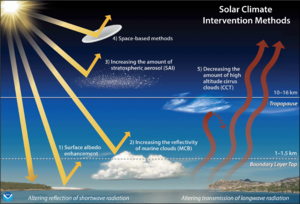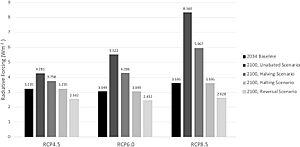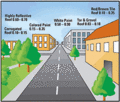Solar geoengineering facts for kids
Solar geoengineering, also called solar radiation modification (SRM), is a big idea to help fight climate change. It involves finding ways to send some of the sunlight that hits Earth back into outer space. This would help cool our planet and reduce the effects of human-caused warming.
It's important to know that solar geoengineering is not a replacement for cutting down on greenhouse gas emissions. Instead, it's seen as a temporary way to slow down warming while we work on reducing these gases and removing carbon dioxide from the air.
If solar geoengineering were to stop suddenly while greenhouse gas levels were still high, it could cause very fast warming. This quick change would be dangerous for plants and animals. Even with this risk, people often talk about solar geoengineering because it could cool the planet much faster and, in the short term, be cheaper than other ways to fight climate change.
Right now, there are no clear international rules for solar geoengineering. This means many questions about how, when, or even if it should be used are still unanswered.
Contents
How Does Solar Geoengineering Work?
Scientists are looking into a few main ways to reflect sunlight:
- Stratospheric aerosol injection (SAI): This involves putting tiny particles, like sulfur dioxide, into the upper atmosphere. These particles would act like a shield, reflecting sunlight away from Earth.
- Marine cloud brightening (MCB): This method would spray tiny drops of sea water into the air over the ocean. This makes clouds brighter and whiter, so they reflect more sunlight.
- Cirrus cloud thinning (CCT): This idea is about making thin, high clouds (called cirrus clouds) disappear. While not strictly about reflecting sunlight, it helps heat escape from Earth, which also cools the planet.
Some research suggests using solar geoengineering to help meet goals like those in the Paris Agreement, which aims to limit global warming to 1.5 or 2 degrees Celsius. It could also be used to cut the current warming in half. This might be less disruptive to societies and nature than trying to go back to pre-industrial temperatures.
There are also ideas to focus solar geoengineering only at the North and South Poles. This could help stop the warming that causes Arctic sea ice decline, permafrost thaw, and ice sheet melt, which leads to sea level rise. However, even the cheapest plans could cost billions of US dollars each year. So, deciding to use these methods would be a very big step.
What Are the Benefits?
Solar geoengineering could cool the planet within months. This means it could quickly reduce climate risks while we work on cutting emissions and removing carbon dioxide.
One method, stratospheric aerosol injection, is expected to be relatively cheap to put into action. This is especially true when compared to the high costs of climate change if we do nothing, or the big costs of aggressively cutting emissions. Also, the direct cooling effects of solar geoengineering can be reversed fairly quickly if needed.
What Are the Risks and Challenges?
Most of what we know about solar geoengineering comes from computer models and studies of volcanic eruptions. These are helpful, but they don't perfectly show what would happen if we actually used these methods. We need more real-world research.
Stopping Suddenly
The cooling effects of solar geoengineering would only last as long as we keep doing it. If we stopped suddenly, especially if greenhouse gas levels were still high, the planet would warm up very quickly. This rapid temperature rise could be more dangerous than a slow, gradual warming.
Some people worry that once we start solar geoengineering, it would be "impossible to stop." But if it's used as a temporary plan for a few decades, it could be stopped.
Disagreements and Control
Even if climate models show the best way to use solar geoengineering, different countries might not agree on whether to use it, how much, or for how long. This could lead to conflicts.
Unwanted Use
There's a risk that some countries might start using solar geoengineering without enough research or safety checks. Many countries have the money and technology to try it on their own.
Uneven Effects
Both climate change and solar geoengineering could affect different parts of the world and different groups of people in various ways. Some say it would create "winners and losers." However, models suggest that a moderate use of solar geoengineering could bring the climate closer to how it was before the industrial age for almost all regions.
Developing countries are often more vulnerable to climate change. This means they might have the most to gain from a careful use of solar geoengineering.
Less Focus on Cutting Emissions
Some worry that if we have solar geoengineering as an option, people might feel less urgent about cutting greenhouse gas emissions. This is sometimes called a "moral hazard" or "risk compensation." Because of this concern, many environmental groups are hesitant to talk about solar geoengineering.
Effect on Sky and Clouds
Using aerosols or changing clouds to reflect sunlight could change how much direct sunlight reaches the Earth. This might slightly reduce the growth rates of tiny ocean plants (phytoplankton), trees, and crops.
Images for kids
-
Changes in ocean pH (how acidic the ocean is) caused by human-made CO2. This ocean acidification will still be a big problem unless we reduce CO2 in the air.
See also
 In Spanish: Geoingeniería solar para niños
In Spanish: Geoingeniería solar para niños
- Climate engineering
- Cloud seeding
- Passive daytime radiative cooling








